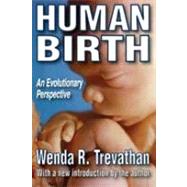
Note: Supplemental materials are not guaranteed with Rental or Used book purchases.
Purchase Benefits
Looking to rent a book? Rent Human Birth: An Evolutionary Perspective [ISBN: 9781412815024] for the semester, quarter, and short term or search our site for other textbooks by Trevathan,Wenda R.. Renting a textbook can save you up to 90% from the cost of buying.
| Introduction to the Paperback Edition | p. vii |
| Acknowledgments | p. xiii |
| Introduction | p. xv |
| Evolutionary Perspectives on Human Birth and Bonding: The Background | |
| Sex | p. 1 |
| Viviparity | p. 4 |
| The Hemochorial Placenta | p. 5 |
| Gestation Length | p. 15 |
| Bipedalism and Parturition | p. 17 |
| Lactation | p. 29 |
| Intensification of Parental Care | p. 32 |
| Summary | p. 33 |
| Issues Relating to the Current Study: The Birth Center, Midwives Mothers, and Methods | |
| Anthropological Interest in Birth and Bonding | p. 35 |
| The Setting: EI Paso and The Birth Center | p. 40 |
| Midwives | p. 45 |
| The Mothers | p. 46 |
| Methodology | p. 51 |
| Ontogenetic and Proximate Factors Influencing Maternal Behavior at Birth and Immediately Postpartum | p. 54 |
| Summary | p. 62 |
| The Process of Parturition | |
| Physiology and Biochemistry of Labor and Delivery in Human Beings | p. 65 |
| Behaviors Associated with Parturition | p. 71 |
| Comparisons of Births in Human and Nonhuman Primates | p. 88 |
| Summary | p. 117 |
| The Newborn Infant | |
| The Neonatal Brain | p. 124 |
| Infant State | p. 127 |
| Neonatal Behavior | p. 129 |
| Variation in Neonatal Behavior | p. 137 |
| Exterogestation | p. 143 |
| Summary | p. 145 |
| Mother-Infant Interaction Immediately After Birth | |
| Tactile Interaction | p. 149 |
| Left-Lateral Preference | p. 158 |
| Visual Communication | p. 166 |
| Auditory Communication | p. 169 |
| Entrainment | p. 176 |
| Nursing | p. 177 |
| Odor | p. 182 |
| Ethograms of Maternal Behavior Immediately after Birth | p. 183 |
| Summary | p. 189 |
| Mother-Infant Bonding At Birth | |
| Mother-Infant Bonding in Nonhuman Mammals | p. 193 |
| Bonding in Human Mothers and Infants | p. 202 |
| An Evolutionary Perspective on the First Hour after Birth | p. 212 |
| An Evolutionary Perspective on Human Birth and Bonding: Conclusions | |
| Readjustments in Birth and the Mother-Infant Bond Throughout Human Evolution | p. 221 |
| Birth and Bonding in a Wider Context | p. 235 |
| Translation of Spanish Dialogues | p. 241 |
| Bibliography | p. 243 |
| Index | p. 261 |
| Table of Contents provided by Ingram. All Rights Reserved. |
The New copy of this book will include any supplemental materials advertised. Please check the title of the book to determine if it should include any access cards, study guides, lab manuals, CDs, etc.
The Used, Rental and eBook copies of this book are not guaranteed to include any supplemental materials. Typically, only the book itself is included. This is true even if the title states it includes any access cards, study guides, lab manuals, CDs, etc.